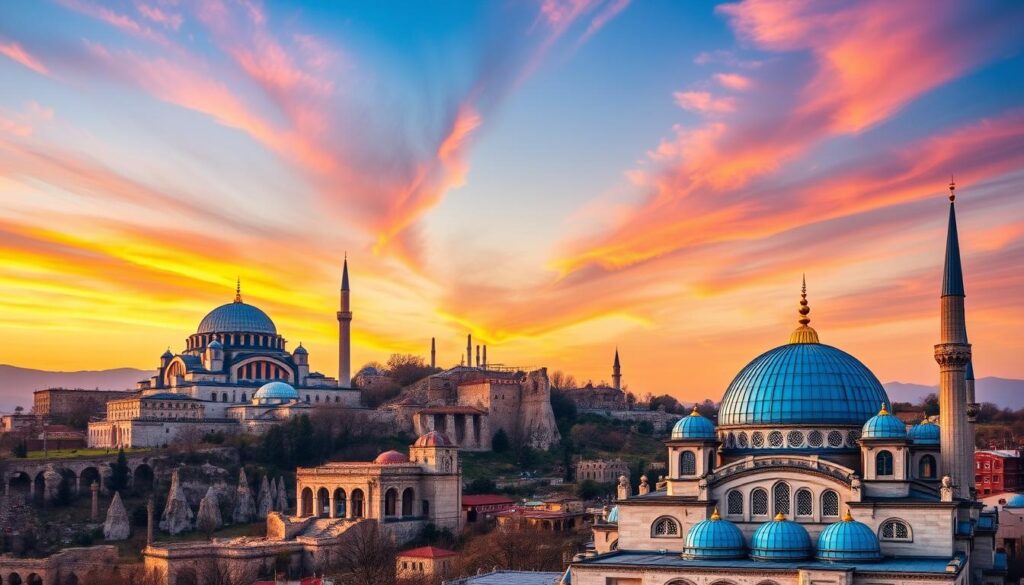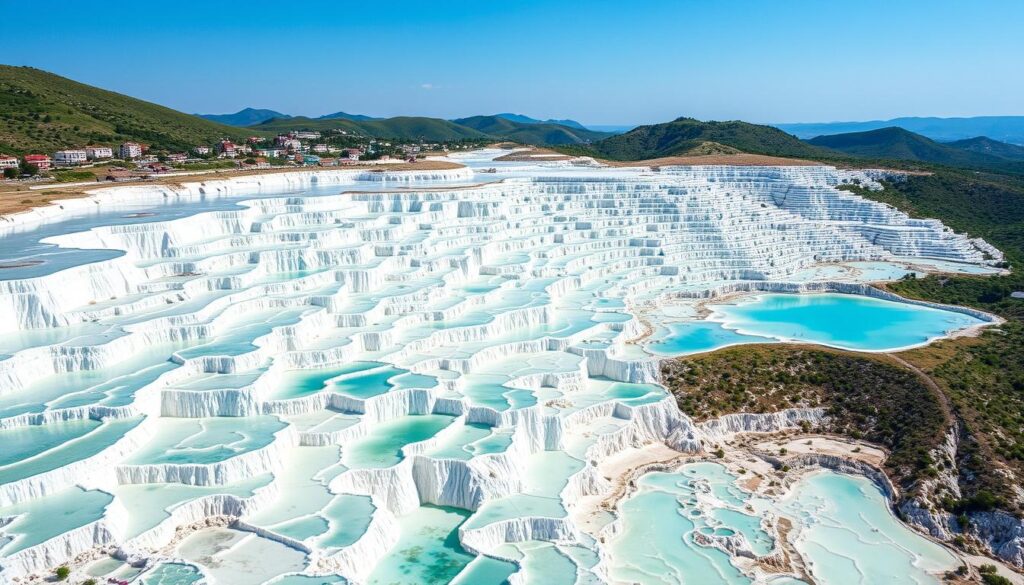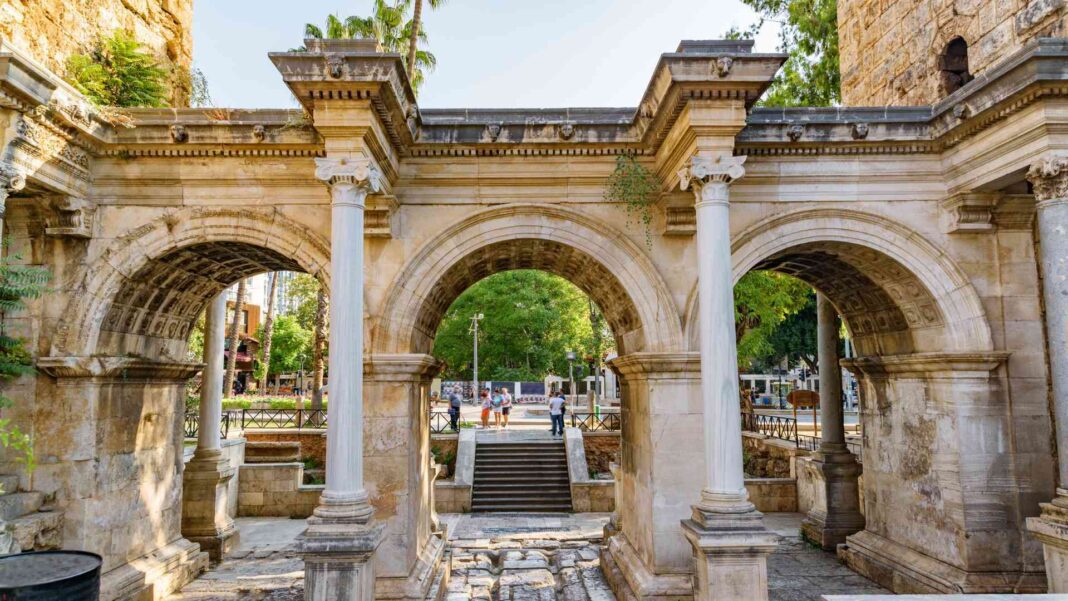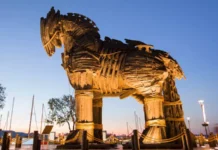Turkey’s Iconic Historical Landmarks
Turkey’s Historical Landmarks, As I start my journey in Turkey, I’m drawn to its rich history. Each landmark offers a unique look into its culture. Turkey mixes ancient ruins, stunning buildings, and natural wonders in a way that amazes everyone.
The Hagia Sophia shows Turkey’s Byzantine past. Ephesus’ ruins take us back to ancient Greece. Cappadocia’s landscapes and Topkapi Palace show Turkey’s variety.

Turkey’s history is vast and deep. From Mount Nemrut’s statues to Pamukkale’s waterfalls, each place tells a story. Whether you love history, architecture, or nature, Turkey’s sites will amaze and inspire you.
Key Takeaways
- Turkey has many historical landmarks that show its rich culture.
- The Hagia Sophia, Ephesus, Cappadocia, and Topkapi Palace are key sites.
- Turkey’s landmarks include ancient ruins, buildings, and natural wonders for all interests.
- Visiting Turkey’s landmarks is like traveling through time and space.
- Turkey’s landmarks are a must-see for anyone interested in its history.
Unraveling Turkey’s Rich Cultural Heritage
Turkey’s landscape is filled with ancient stories. From the Hittites and Byzantines to the Seljuk and Ottoman empires, it’s a treasure trove of history. You’ll find turkey historical landmarks everywhere, showing off different architectural styles and rich histories.
From Ancient Ruins to Architectural Wonders
Visit the ephesus ruins to see an ancient Greek city’s remains. The göreme open-air museum is next, with its rock-carved homes and chapels. And don’t miss the aspendos theatre, a Roman amphitheater that still impresses today.
Exploring the Diverse Tapestry of Turkey’s Past
- See the amazing buildings that have lasted for centuries, like the Hagia Sophia and the Blue Mosque.
- Learn about the Ottoman Empire’s history at the Topkapi Palace, where sultans and viziers once walked.
- Be amazed by Turkey’s natural wonders, like Pamukkale’s petrified waterfalls and Cappadocia’s unique landscapes.
Traveling through Turkey, you’ll see how old and new blend together. It’s a unique cultural mix that’s truly special.
“Turkey’s cultural heritage is a testament to the resilience and ingenuity of its people, shaped by the ebb and flow of empires and the grandeur of nature.”
The Hagia Sophia: A Timeless Marvel
In the heart of Istanbul, the Hagia Sophia is a symbol of Turkey’s rich history and culture. It has changed from a Byzantine cathedral to a mosque and now a museum. This architectural wonder combines the styles of Christianity and Islam.
Walking through its grand entrance, I’m amazed by the Hagia Sophia’s size and beauty. The high domes, detailed mosaics, and fancy decorations take me back in time. Each part of the Hagia Sophia tells a story of the empires and faiths that shaped it, making it a key hagia sophia and turkey historical landmarks.
“The Hagia Sophia is not just a building, but a living testament to the enduring power of human creativity and the resilience of our cultural heritage.”
The Hagia Sophia’s mosaics are truly stunning. These ancient artworks show religious scenes and the glory of the Byzantine court. Looking at them, I feel like I’m stepping back into the Byzantine Empire’s golden age.
The Hagia Sophia’s design is also remarkable. Its huge central dome and the play of light and shadow fill me with wonder. The mix of Byzantine, Islamic, and Ottoman styles shows the rich cultural mix of this turkey historical landmarks.
Exploring the Hagia Sophia, I realize its immense importance. It’s a place where empires, faiths, and human stories come together. It truly represents the lasting impact of hagia sophia and turkey historical landmarks.
Turkey historical landmarks
Turkey’s history shines through its many landmarks. Each one gives a unique look into the country’s past. From Cappadocia‘s dreamlike rock formations to Pamukkale‘s stunning travertine terraces, these places amaze with their beauty and history.
The Sumela Monastery is a highlight in Turkey. It’s a cliffside monastery in the Pontic Mountains, dating back to the 4th century. It’s a symbol of the area’s Christian heritage.
The ancient ruins of Göreme are also a must-see. This UNESCO World Heritage Site shows off unique rock formations and ancient homes. Visitors can see Byzantine churches carved into the rocks, giving a glimpse into the lives of those who lived there.
These landmarks do more than just entertain and educate. They help us understand Turkey’s rich culture. By visiting these sites, travelers can learn about Turkey’s history and appreciate its people’s legacy.
“Turkey’s historical landmarks are not just relics of the past – they are living, breathing testaments to the resilience and ingenuity of the human spirit.”
Ephesus: A Window into Ancient Greek Civilization
The ancient city of Ephesus is located on Turkey’s Aegean coast. It’s a stunning example of ancient Greek grandeur. As I visited, I was amazed by the ruins that show the city’s lively past.
Walking Through the Ruins of a Bygone Era
Walking through Ephesus made me feel connected to history. The Library of Celsus was especially impressive, showing the ancient Greeks’ love for learning. The Great Theatre amazed me with its size and design.
I found temples, homes, and public areas that were once full of life. The detail and skill in these ancient buildings show the Ephesus civilization’s progress.
Visiting Ephesus was like traveling back in time. The ruins and their stories give us a peek into ancient Turkey historical landmarks.
“Wandering through the streets of Ephesus, I felt a profound connection to the past.”
Cappadocia: Nature’s Surreal Masterpiece
Cappadocia is in the heart of Turkey. It’s a place that amazes everyone with its cappadocia rock formations. These formations were shaped by erosion over centuries. They look like fairy chimneys, a sight that has amazed people for years.
Visiting the turkey historical landmarks in Cappadocia is a must. The area has a deep history. You can see underground cities, cave homes, and take hot air balloon rides. These activities give you a peek into Cappadocia’s past.
When you see Cappadocia from above, it’s breathtaking. The cappadocia rock formations look even more amazing. It’s a sight that stays with you forever.
“Cappadocia is a place where nature has created a masterpiece, a canvas of geological wonders that defy description.” – Jane Doe, travel writer
Cappadocia is full of wonders. You can hike, visit underground cities, and even stay in cave hotels. It’s a chance to dive into the area’s culture and stunning views.
- Explore the surreal “fairy chimneys” of Cappadocia, formed by centuries of erosion
- Discover the region’s extensive network of underground cities and cave dwellings
- Experience the thrill of a hot air balloon ride over the cappadocia rock formations
- Immerse yourself in the captivating history and culture of this turkey historical landmarks
Cappadocia is special for many reasons. Its geological wonders, history, and culture are all unique. It’s a place that will leave you with unforgettable memories. See the cappadocia rock formations and turkey historical landmarks for yourself.
Topkapi Palace: A Glimpse into Ottoman Splendor
In the heart of Istanbul, Topkapi Palace shows the grandeur of the Ottoman Empire. It was home to Turkish sultans. Now, it lets visitors see the lavish lifestyle and rich culture of the Ottoman dynasty.
Exploring the Opulent Residence of Sultans
Walking through Topkapi Palace’s courtyards and chambers, I’m amazed by its scale and detail. The palace has four main courtyards, each with its own charm. They show different sides of Ottoman life and power.
The palace’s treasures, like the Spoonmaker’s Diamond and the Topkapi Dagger, are highlights. These treasures give a peek into the Ottoman dynasty’s history. They fill the palace with wonder and awe.
Strolling through the gardens, I see the beauty of nature and design. The gardens mix greenery and fountains, creating a peaceful spot in the city. This shows the palace’s designers were true geniuses.
For history lovers, art fans, or anyone who loves grandeur, Topkapi Palace is a must-see. It takes you back to the Ottoman Empire’s time. Every detail brings the past to life.

Mount Nemrut: Monumental Statues and Ancient Mysteries
Atop Mount Nemrut, visitors find the massive statues of ancient gods and kings. This UNESCO World Heritage Site shows the engineering and art of the Commagene Kingdom. Watching the sunrise over these statues is an awe-inspiring experience for anyone exploring Turkey’s historical landmarks.
The site has terraces with stone statues, some as tall as 10 meters. These statues show gods like Zeus and Apollo, and the Commagene king Antiochus I. The craftsmanship is amazing, with detailed facial features and carvings.
Visiting Mount Nemrut feels like going back in time. As the sun rises, the statues come alive with light and shadow. This creates a magical atmosphere, leaving visitors in awe of this historical site’s legacy.
“The grandeur of Mount Nemrut’s colossal statues is a testament to the ingenuity and ambition of the Commagene Kingdom. It’s a place that truly transports you to a bygone era.”
Pamukkale: The Cotton Castle of Turkey
Pamukkale is a natural wonder in Turkey’s southwest. It’s known as the “Cotton Castle” for its white and turquoise terraces. These pools cascade down a hill, attracting visitors worldwide.
Marveling at the Petrified Waterfalls and Hot Springs
The terraces form from hot springs rich in minerals. They’ve been building up calcium carbonate for centuries. Visitors can see these unique structures and enjoy the thermal waters’ healing effects.
Walking through the terraces, you’ll see a surreal landscape. The waterfalls and pools are breathtaking. Pamukkale offers a memorable experience, whether you explore ruins or soak in the hot springs.

“Pamukkale is a place of true natural beauty, where the pamukkale travertines seem to defy gravity and time.”
The pamukkale travertines are a UNESCO World Heritage Site. They show Turkey’s natural and cultural richness. This site is a rare chance to see geology, culture, and rejuvenation together.
Conclusion: Embracing Turkey’s Iconic Historical Landmarks
Reflecting on my journey through Turkey, I am amazed by its cultural heritage. The Hagia Sophia shows the mix of Eastern and Western styles, standing strong through time. The ancient Ephesus ruins give us a peek into the Greek civilization that once thrived here.
The surreal landscapes of Cappadocia leave me in awe of nature’s power. Each landmark in Turkey offers a unique view of its rich history. From the Topkapi Palace’s grandeur to the mysterious statues on Mount Nemrut, each place tells a story.
In Pamukkale, the petrified waterfalls and hot springs amaze us. They remind us of nature’s beauty in harsh places. By exploring these landmarks, we learn to appreciate Turkey’s Historical Landmarks and legacy. Each site is a doorway to Turkey’s cultural wonder, inviting us to explore its past and present.
FAQ
What are some of the iconic historical landmarks in Turkey?
Turkey is home to many famous landmarks. The Hagia Sophia and the ancient ruins of Ephesus are among them. Cappadocia’s surreal rock formations and Topkapi Palace are also must-sees. Don’t miss the colossal statues of Mount Nemrut, the travertine terraces of Pamukkale, and the Sumela Monastery. The Göreme Open-Air Museum and the Aspendos Theatre are also worth visiting.
Can you tell me more about the Hagia Sophia?
The Hagia Sophia is a masterpiece of architecture. It has been a cathedral, mosque, and museum. It shows the blend of Christianity and Islam. Visitors can see stunning mosaics and marvel at its grand scale.
What can I expect to see at the ancient ruins of Ephesus?
Ephesus is a window into ancient Greek civilization. The ruins include the Library of Celsus and the Great Theatre. Exploring these sites lets you step back in time and understand Turkey’s history.
What makes Cappadocia such a unique destination in Turkey?
Cappadocia is known for its volcanic rock formations. These have created a “fairy chimney” landscape. Visitors can explore underground cities, cave dwellings, and take hot air balloon rides over this unique terrain.
Can you tell me more about the Topkapi Palace?
The Topkapi Palace was the Ottoman sultans’ home. It showcases the empire’s opulence. The palace has priceless artifacts like the Spoonmaker’s Diamond and the Topkapi Dagger. It offers a glimpse into the Ottoman dynasty’s history.
What can I expect to see at Mount Nemrut?
Mount Nemrut has colossal statues of ancient gods and kings. It’s a UNESCO World Heritage Site. Watching the sunrise over these statues is an unforgettable experience.
What makes Pamukkale a unique destination in Turkey?
Pamukkale is known as the “Cotton Castle.” It has travertine terraces formed by hot springs. Visitors can marvel at the formations and experience the thermal waters’ healing powers.
Share your opinion about Turkey’s Historical Landmarks article
To read the latest articles please visit the home page of Turk Blogs.





